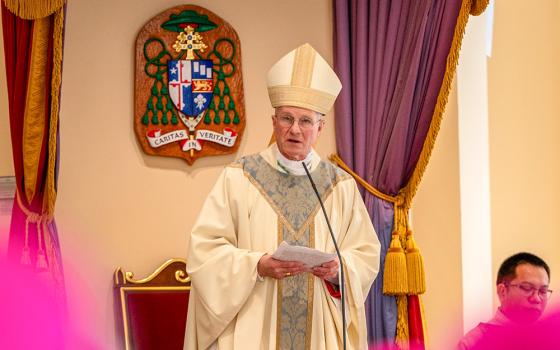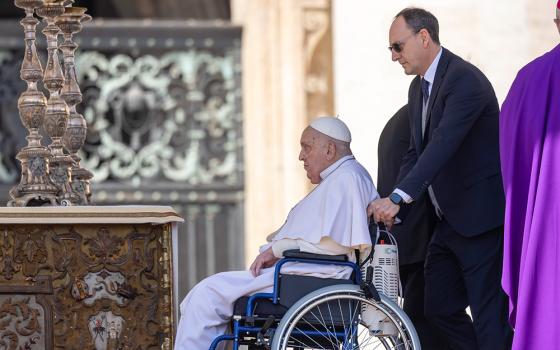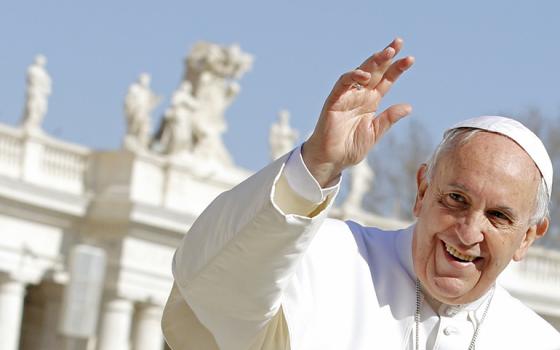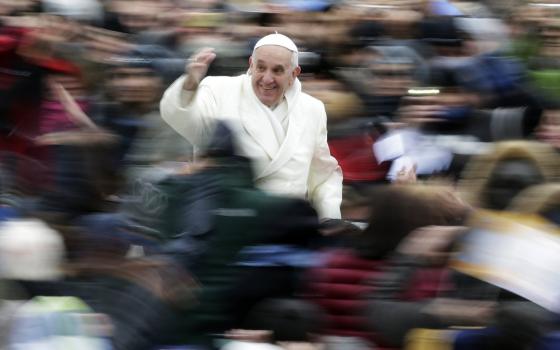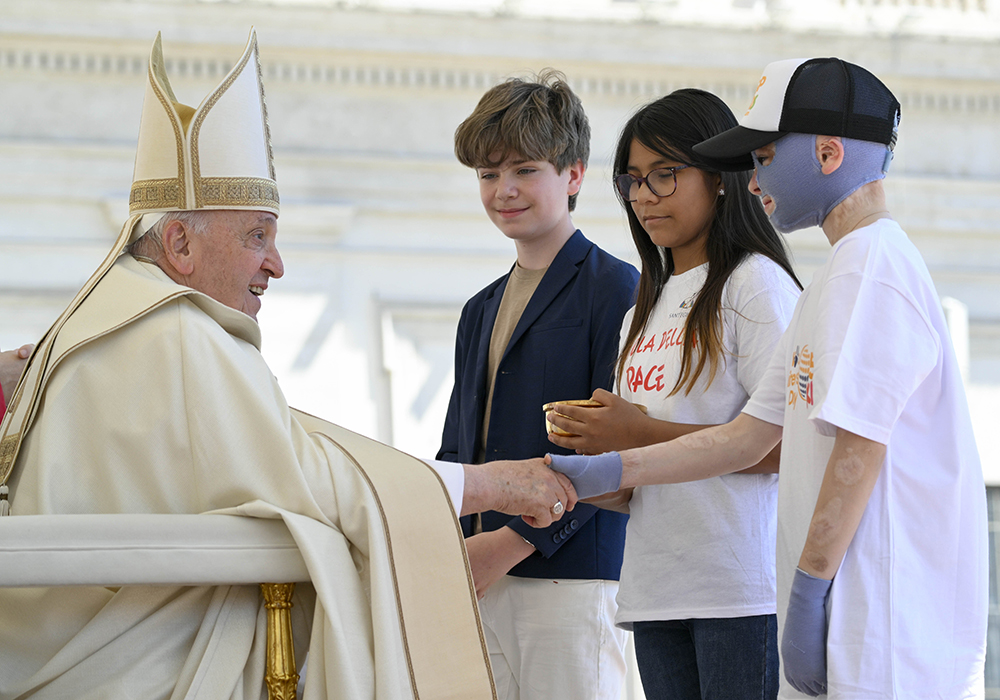
Pope Francis greets children bringing the offertory gifts during Mass in St. Peter's Square at the Vatican May 26, 2024, wrapping up the first World Children's Day held May 25-26. The pope shakes hands with Roman Oleksiv, a Ukrainian boy who lost his mother and suffered life-threatening burns from a Russian missile strike July 14, 2022. (CNS/Vatican Media)
The death of Pope Francis leaves the church in mourning.
We grieve not just the passing of a pope, but the loss of a holy witness — one who led not with thunder but with tenderness, not with grandeur but with quiet grace. His papacy, marked by gestures of humility, fierce compassion and deep reverence for the human person, has come to a close. Yet in these first days of loss, it is clear that his echo will resound for years to come.
To the very end, Francis continued to teach. He was a man who taught with his hands, extending them in blessing, in washing and in embracing the wounded, the poor and the forgotten. Even as his strength waned, his witness only deepened. In his silence, he continued to speak. In his stillness, he challenged us. His last days became a kind of living homily, rooted in prayer, tenderness and a sacramental vision of life.
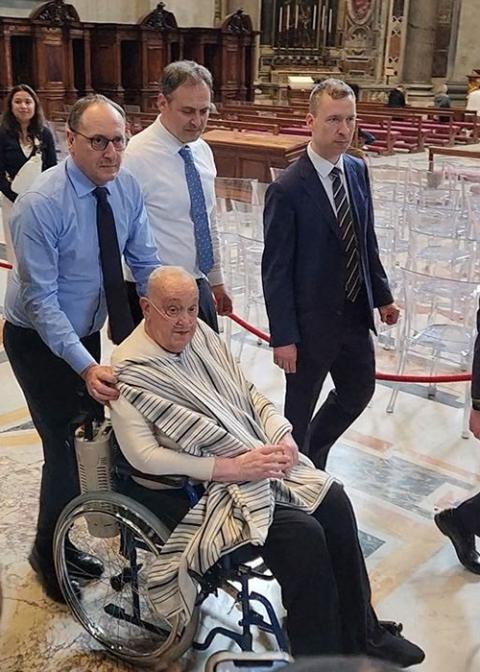
Pope Francis makes a surprise visit to St. Peter's Basilica at the Vatican to pray April 10, 2025. (OSV News/Luiz Gil, Handout via Reuters)
Francis' two feet stood firmly on sacred ground: one planted in the long tradition of sacramental seeing — a way of beholding creation with wonder and gratitude, finding God in beauty, fragility and form. The other grounded in sacred Scripture, especially the radical, often uncomfortable Gospel call to justice, humility and mercy. He was never content to leave the Beatitudes on the page. He lived them. His quietness spoke loudly. And now, in death, his silence rings out to bless us — and to challenge us.
Just days ago, one of his final public moments offered a quiet parable. Inside St. Peter's Basilica, beneath Michelangelo's magnificent dome, two art restorers — Lorena Araujo Pinheiro and Michela Malfatti — stood with hands dusted in marble, restoring the tomb of Pope Urban VIII. Into the hush rolled the wheels of a simple chair. A man approached, draped not in vestments but in humility. A scarf lay across his lap. No entourage. No ceremony. Just presence.
"He thanked us many times for the work," Malfatti said to Associated Press. "Then he asked me if he could take my hand because his were cold. He was very sweet with us."
Pietro Zander, who oversees the basilica's artistic heritage, called it "a blessing of the end of the work." And so it was — an unplanned moment of reverence — a sacrament of encounter.
This was not an isolated gesture. On Feb. 16, too ill to attend in person, Francis still spoke at the Jubilee of Artists — this time through the voice of Cardinal José Tolentino de Mendonça. It was not merely a homily. It was a summons.
"True hope," he said, "is interwoven within the drama of human existence. Hope is not a convenient refuge, but a fire that burns and irradiates light, like the word of God."
He addressed the vocation of the artist: "Art is not a luxury, but something the spirit needs. It is not a flight from reality, but a charge, a call to action, an appeal and a cry. Educating about true beauty is educating about hope."
Francis never viewed beauty as a distraction. For him, it was an encounter. Resistance. Gospel. The artist, he believed, stands at the border of mystery and meaning, not to retreat from the world's suffering, but to enter it more fully and help the rest of us see.
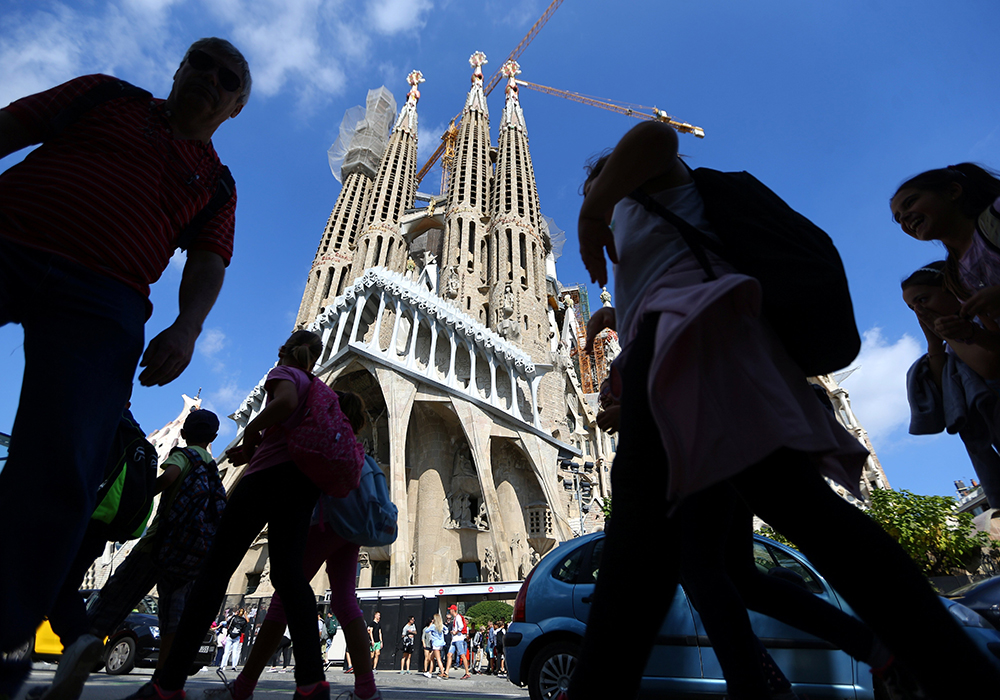
The Basilica of the Holy Family, or Sagrada Família, in Barcelona, Spain, designed by famed Spanish architect Antoni Gaudí, is seen in this March 13, 2020, photo. On April 14, 2025, Pope Francis declared Gaudí venerable, recognizing his heroic virtues in a decree announced during a Vatican audience with Cardinal Marcello Semeraro. (OSV News/Reuters/Ivan Alvarado)
This is not a theoretical theology. It is incarnate. In his final days, Francis spoke less but continued to reveal more. Whether in a basilica encounter or in declaring Antoni Gaudí venerable, Francis elevated sacred creativity as an essential ministry. Not adornment. Not ornament. A core witness.
Gaudí's life was a liturgy in stone. He saw every curve of nature as a divine brushstroke. He poured his soul into the Sagrada Familia, never seeing its completion, because he believed the true architect was God. His sacred architecture, filled with light, form and mystery, reminds us that beauty itself can become a kind of Eucharist.
Francis seemed to grow increasingly comfortable with his diminishing figure. His entire pontificate served as a bookend to the Second Vatican Council, whose documents shaped his papacy. His sense of the sacred and of art itself is found in the first major council document, promulgated in 1963, Sacrosanctum Concilium, the Constitution on the Sacred Liturgy. It said that sacred art must be "worthy, becoming, and beautiful"— because beauty reveals the "infinite beauty of God." It implied that the church must encourage artists whose work uplifts the soul and serves the sanctity of the people.

Pope Francis appears on the central balcony of St. Peter’s Basilica to deliver his Easter blessing "urbi et orbi" (to the city and the world) at the Vatican on April 20, 2025. (CNS photo/Vatican Media)
Francis lived that encouragement. He knew that the Catholic imagination has always been rooted in both form and fire — in the careful beauty of the altar and the raw power of the Gospel. He understood that art is not separate from justice. That the curve of a dome, the song of a cantor, the silence of a sculpture — these are not flourishes. They are forms of prayer.
And prayer, he taught us, is not always spoken. Sometimes it is the hush of marble dust. The warmth of a scarf in winter. The quiet of a dying pope's last act of reverence.
Now, as we grieve him, we will see again and again the images of St. Peter's Square. The arms of the colonnade will gather the world's sorrow. But if we follow his gaze — if we see not just structure, but sacrament — then we may enter that space anew: not as tourists, but as pilgrims of beauty, not as mourners, but as witnesses of hope. For Francis, beauty was never passive. It was revolutionary. It was the face of God reflected in the dignity of the vulnerable and the rhythm of mercy. He taught us that to see sacramentally is not to withdraw from the world, but to love it more fiercely. To see, and then to act.
Advertisement
